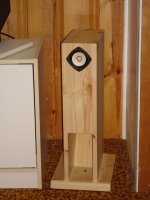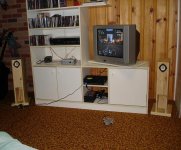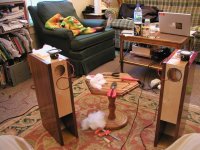Hi Jonastus,
Hey, I'm making those too! How did you do the stuffing stuff?
Later today I'll try to sand the inner parts, so the second side will fil properly, and start to listen to them.
How do you like them, and are you planning to add somethig to fill the lower end? (up to 140hz. or so)
Regards, Paul
Hey, I'm making those too! How did you do the stuffing stuff?
Later today I'll try to sand the inner parts, so the second side will fil properly, and start to listen to them.
How do you like them, and are you planning to add somethig to fill the lower end? (up to 140hz. or so)
Regards, Paul
hi,
Just finished the first one of my pair yesterday.
I've been listening to them for a while (before finishing thus) with one of the sides just clamped on.
Did just a little stuffing (a bit in the chamber, and the 2nd part of the horn. Both not really dense or so) and that's all.
It sounded quite nice, so I thought: Glue'n'screws time.
Mince! Zut alors! It sounds worse than ANY $5 powered PC speaker piece-o-sh*t... (Sorry for the language, but I'm really p-ed off!)
Amazing how the sound changed, unfortunatly in the wrong direction.
I'd say: Better bass, more lower end extention (Hey, that's positive!), very, very dominant between low-mid and higher mids, and no high anymore.
Stuffing the mouth with a lagre cloth or sheet, thus killing the horn, makes the sound more 'supportable'.
What kills me is the lack of high: The mid *could* be put back to normal by stuffing the horn, right? (but it's past glue'n'screws time, remember )
)
Anyone some good hint? Have a look at the design, and you'll notice that the first piece of horn is quite accessible via the chamber, and the last pieces as well: I've got tiny, skinny hands, so....
Should I stuff till death the chamber? Empty it? Fill it with coffee or champange? Burn the bl**dy thing?
And why don't they say ANYTHING about the amount & density of the stuffing needed in the design? Sarcastic fostex blokes...
Have a nice day, and remember: YOU could make ME have a nice day tomorrow, just by providing some hints'n'ideas!
Paul
Just finished the first one of my pair yesterday.
I've been listening to them for a while (before finishing thus) with one of the sides just clamped on.
Did just a little stuffing (a bit in the chamber, and the 2nd part of the horn. Both not really dense or so) and that's all.
It sounded quite nice, so I thought: Glue'n'screws time.
Mince! Zut alors! It sounds worse than ANY $5 powered PC speaker piece-o-sh*t... (Sorry for the language, but I'm really p-ed off!)
Amazing how the sound changed, unfortunatly in the wrong direction.

I'd say: Better bass, more lower end extention (Hey, that's positive!), very, very dominant between low-mid and higher mids, and no high anymore.
Stuffing the mouth with a lagre cloth or sheet, thus killing the horn, makes the sound more 'supportable'.
What kills me is the lack of high: The mid *could* be put back to normal by stuffing the horn, right? (but it's past glue'n'screws time, remember
 )
)Anyone some good hint? Have a look at the design, and you'll notice that the first piece of horn is quite accessible via the chamber, and the last pieces as well: I've got tiny, skinny hands, so....
Should I stuff till death the chamber? Empty it? Fill it with coffee or champange? Burn the bl**dy thing?
And why don't they say ANYTHING about the amount & density of the stuffing needed in the design? Sarcastic fostex blokes...
Have a nice day, and remember: YOU could make ME have a nice day tomorrow, just by providing some hints'n'ideas!
Paul
Old Fostex Wisdom:
Let them break in for a very very long time before doing any permanent damping or glueing.
Since they are fitted already with the box glued tight, let them break in right now for 50-100 hours and wait for the sound to clear up. Big chance you will be surprised after this. If not, use your tiny little hands. After that use the left-over champagne to celebrate these little miracles and sent the remaining bottles to me. Btw. you're not a fan of techno, right?
Let them break in for a very very long time before doing any permanent damping or glueing.
Since they are fitted already with the box glued tight, let them break in right now for 50-100 hours and wait for the sound to clear up. Big chance you will be surprised after this. If not, use your tiny little hands. After that use the left-over champagne to celebrate these little miracles and sent the remaining bottles to me. Btw. you're not a fan of techno, right?
Doc,
Thanks for your encouraging reply!
but, hey, you know what? I said I've got small & tiny hands, but there are indeed some even smaller and tinier hands in my house, and didn't those particular hands touched my, almost hidden, poweramp? Yes, my little 4 years old managed to fiddle around with the dials of my old SS yamaha amp... Stoute man!
He turned the variable loudness all the way in, the bass out etc. etc....
So when I realised this, and corrected his intentions, the sound 'as-I-knew-it' came back!!! OUF!!!
So, nothing wrong! There's still some 'not-quite-perfectness' in the drivers, but as you said, and as I read around, there's still a lot of breaking in to be done.
Started the 2nd one ysterday, I think I'll finish that one this weekend, so I can enjoy a complete fullrange system, instead of just one channel.
Paul
BTW: I'm thinking of building a WO-36 to fill the lower end. any thoughts about this one? (Haven't quite decided on a driver though)
Thanks for your encouraging reply!
but, hey, you know what? I said I've got small & tiny hands, but there are indeed some even smaller and tinier hands in my house, and didn't those particular hands touched my, almost hidden, poweramp? Yes, my little 4 years old managed to fiddle around with the dials of my old SS yamaha amp... Stoute man!
He turned the variable loudness all the way in, the bass out etc. etc....
So when I realised this, and corrected his intentions, the sound 'as-I-knew-it' came back!!! OUF!!!
So, nothing wrong! There's still some 'not-quite-perfectness' in the drivers, but as you said, and as I read around, there's still a lot of breaking in to be done.
Started the 2nd one ysterday, I think I'll finish that one this weekend, so I can enjoy a complete fullrange system, instead of just one channel.
Paul
BTW: I'm thinking of building a WO-36 to fill the lower end. any thoughts about this one? (Haven't quite decided on a driver though)
greetings, speaking of little hands and stout determination and to avoid heartache I would get some grills to cover your drivers. Science has proven that small children infact have a magnet in their finger that is attracted to dust caps and......... well you know the rest. I speak from experience(fe103e) cheers and good luck
cheers fergs
cheers fergs
very nicely done! I'm considering making these but cast from concrete, and in doing so making the horn expand smoothly rather than in steps like the design shows. Just how is the bass? I don't expect much, the frequency response graph on the PDF shows a bit of lift at about 100hz, presumably from the horn, and not much under. Can they be used for much without a sub?
the horn
here is a pair I made a while back. it took a long time to get them to the point that I could actually listen too them.
in the end, I have been meaning to do another build in the style of maclementhorn, the italian diy website. they have a link to a picture of an example of damping. not stuffed hard anywhere (that is not very dense damping they use there). however, each spot is hit. kills dynamics though. You could decrease or increase these amounts as necessary.
the fe87e is a VERY special driver in the nearfeild. the bump at 200 hz give the needed presence. the upper frequencies are HUGE sounding. they expand far off that little dust cap and sound etherial even. everything in between is just gravy. their playback in the nearfield gives a grand idea from nothingness. Highly adddictive in open baffles. Too little bass to impress friends. when people ask me though what the "end of the road" is like in this audio stuff, I point them to this little driver in an OB. funny how the end resembles the beginnings. disciplinary symmetry.
in the horn, we get some of the greatness and some of the problems with back horns. STRONG bass to 80hz though. even a little lower. the hole at 150 or so does come about as predicted though it is not nearly as profound as the graph would suggest.
I think the problem in mine was that they are never able too settle down. those panels of solid walnut (while expensive, and wonderful mass loaders), I think are constantly expanding and contracting, like any panel of wood should. however, this bending and forming means that it is pulling and pushing the small panels inside the horn (which were 15mm birch ply), and that the process never stops. those are inch thick panels, and while they won't warp much here and there, they are WAY stronger though about the same density as the 15mm stuff. any casual study of acoustics leads us to the notion that a resonant frequency of an object is determined by various material factors and the tension it is under. as tension increases, so does pitch.
wood panels under high tension resonate at higher frequencies than those under less tension. so THAT is why our backhorns initially sound "honky" when excited (plucked) by musical signals. that honk is the summation of the resonant frequency pitch of the entire horn, in fact, though it is concentrated I think in the first few in the sound road. In the beginning, after having all the warps pulled out during construction, the panels are under great tension, even after clamps are removed. after a while though (like a long while) the panels learn to accept their shape as final, though drastic humidity variations in short periods of time (which can also be caused by moving) will also give an old horn honk with a vengeance. it is similar to musicians. those under great tension and stress never perform their best. puts a whole new perspective on my music department head who is self admitted as anal retentive. a brilliant pianist in private, but a mediocre performer (IMO).
some time, I will get a hygrometer along side my mike and digital audio interface. then I will be able to do long term tests of this horn honk for new and old enclosures...the weather out here in walla walla is certainly crazy enough to play around with the musical instruments of the symphony hall...it was 60 and fairly dry the other day during a performance! that is right after a week of 20 degrees and 95 percent humidity.
well, later dudes and dudettes,
Clark
here is a pair I made a while back. it took a long time to get them to the point that I could actually listen too them.
in the end, I have been meaning to do another build in the style of maclementhorn, the italian diy website. they have a link to a picture of an example of damping. not stuffed hard anywhere (that is not very dense damping they use there). however, each spot is hit. kills dynamics though. You could decrease or increase these amounts as necessary.
the fe87e is a VERY special driver in the nearfeild. the bump at 200 hz give the needed presence. the upper frequencies are HUGE sounding. they expand far off that little dust cap and sound etherial even. everything in between is just gravy. their playback in the nearfield gives a grand idea from nothingness. Highly adddictive in open baffles. Too little bass to impress friends. when people ask me though what the "end of the road" is like in this audio stuff, I point them to this little driver in an OB. funny how the end resembles the beginnings. disciplinary symmetry.
in the horn, we get some of the greatness and some of the problems with back horns. STRONG bass to 80hz though. even a little lower. the hole at 150 or so does come about as predicted though it is not nearly as profound as the graph would suggest.
I think the problem in mine was that they are never able too settle down. those panels of solid walnut (while expensive, and wonderful mass loaders), I think are constantly expanding and contracting, like any panel of wood should. however, this bending and forming means that it is pulling and pushing the small panels inside the horn (which were 15mm birch ply), and that the process never stops. those are inch thick panels, and while they won't warp much here and there, they are WAY stronger though about the same density as the 15mm stuff. any casual study of acoustics leads us to the notion that a resonant frequency of an object is determined by various material factors and the tension it is under. as tension increases, so does pitch.
wood panels under high tension resonate at higher frequencies than those under less tension. so THAT is why our backhorns initially sound "honky" when excited (plucked) by musical signals. that honk is the summation of the resonant frequency pitch of the entire horn, in fact, though it is concentrated I think in the first few in the sound road. In the beginning, after having all the warps pulled out during construction, the panels are under great tension, even after clamps are removed. after a while though (like a long while) the panels learn to accept their shape as final, though drastic humidity variations in short periods of time (which can also be caused by moving) will also give an old horn honk with a vengeance. it is similar to musicians. those under great tension and stress never perform their best. puts a whole new perspective on my music department head who is self admitted as anal retentive. a brilliant pianist in private, but a mediocre performer (IMO).
some time, I will get a hygrometer along side my mike and digital audio interface. then I will be able to do long term tests of this horn honk for new and old enclosures...the weather out here in walla walla is certainly crazy enough to play around with the musical instruments of the symphony hall...it was 60 and fairly dry the other day during a performance! that is right after a week of 20 degrees and 95 percent humidity.
well, later dudes and dudettes,
Clark
Attachments
- Status
- This old topic is closed. If you want to reopen this topic, contact a moderator using the "Report Post" button.
- Home
- Loudspeakers
- Full Range
- fostex recomended box fe87


